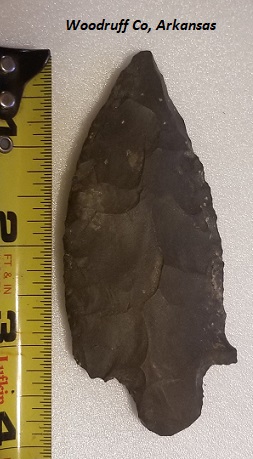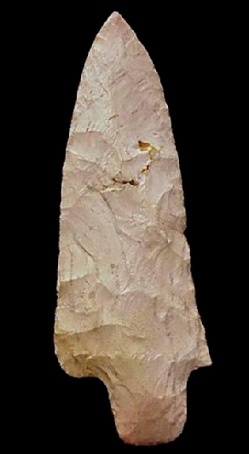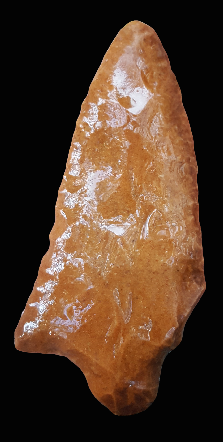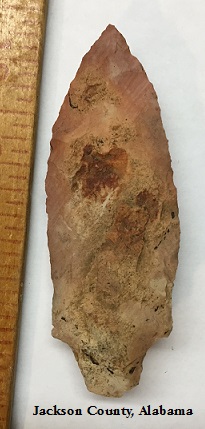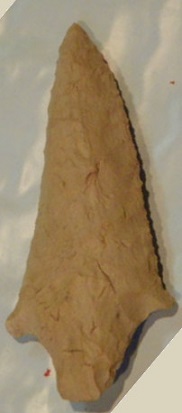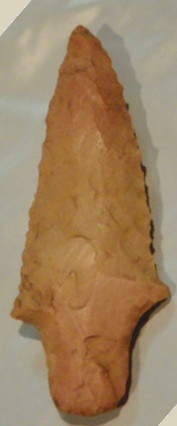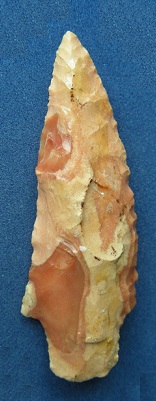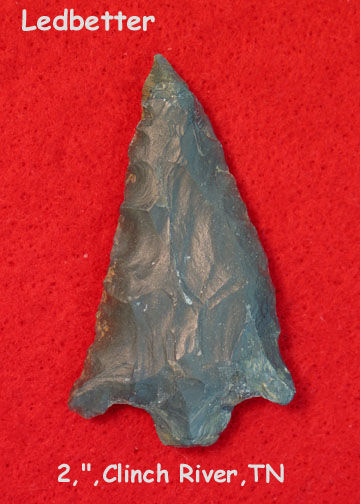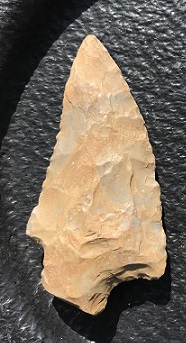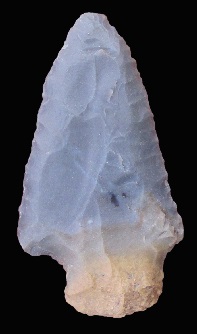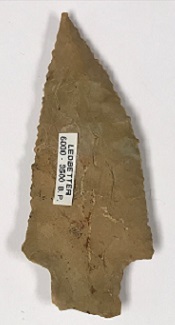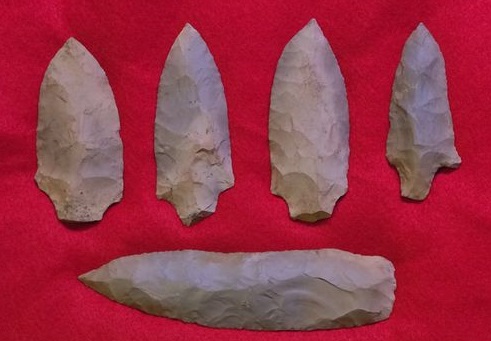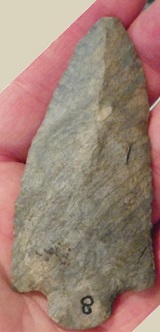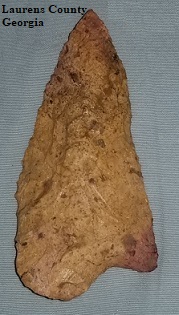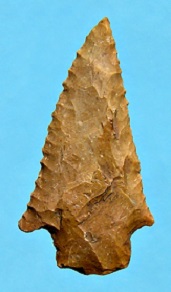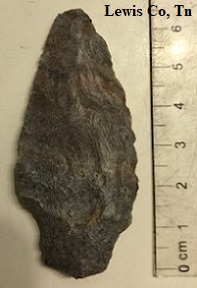Outline is Representative of Size and Shape:
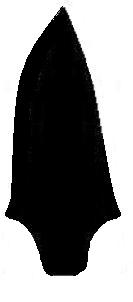
Name Details:
Identified By: Madeline Kneberg
Named For: Type Site
Date Identified: 1956
Type Site: Ledbetter Site, Benton County, Tennessee
Identified By: Madeline Kneberg
Named For: Type Site
Date Identified: 1956
Type Site: Ledbetter Site, Benton County, Tennessee
Point Validity:
Valid type
Kneberg was a prominent anthropologist and professor at the University of Tennessee. She is most recognized for her excavations through-out the Tennessee River Valley. This type was named in a professional publication and has many professional references. This is considered a valid type.
Ledbetter Stemmed
Cluster: Ledbetter Stemmed Cluster Description of Physical Characteristics and Flaking Pattern:
This is a medium to large (2.25 to 4.00 inches) asymmetrical triangular point with an elliptical cross section. The defining feature of this blade is asymmetry. One blade may be an outward recurvate on one side and inward recurvate on the other side (Kneberg 1956). Some examples may have one excurvate blade and one straight blade. The shoulders are also asymmetrical with one side being broader than the other and one shoulder being horizontal and the other sloping upwards. The base may vary from slightly expanding to slightly contracting. The base is most commonly straight. This point is made This point has a random flaking pattern.
Size Measurements:
Total Length - 55 to 100 (average 65 to 75 mm), Stem Length - 8 to 18 mm (average 12 to 14 mm) , Blade Width - 25 to 53 mm (average 35 to 45 mm), Stem Width at shoulders- 16 to 25 mm (typically 18 to 21 mm), Basal Width - 11 to 19 mm (average 13 to 15 mm) Thickness - 9 to 13 mm.
Total Length - 55 to 100 (average 65 to 75 mm), Stem Length - 8 to 18 mm (average 12 to 14 mm) , Blade Width - 25 to 53 mm (average 35 to 45 mm), Stem Width at shoulders- 16 to 25 mm (typically 18 to 21 mm), Basal Width - 11 to 19 mm (average 13 to 15 mm) Thickness - 9 to 13 mm.
Commonly Utilized Material:
Additional Comments:
This is believed to be a Knife, possible used by the same culture that utilized the Pickwick point.
The key distinguishing feature of this point is the asymmetry of the blade and shoulders (Kneberg, 1956).
The bottom left picture is a Ledbetter cache which was found in Kentucky which included an asymmetrical knife blade.
This is believed to be a Knife, possible used by the same culture that utilized the Pickwick point.
The key distinguishing feature of this point is the asymmetry of the blade and shoulders (Kneberg, 1956).
The bottom left picture is a Ledbetter cache which was found in Kentucky which included an asymmetrical knife blade.
Distribution: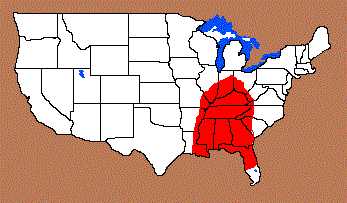
Distribution Comments:
This point is primarily found in the Tennessee River valley and into the Gulf Coast. This point has been found with less frequency into southern Illinois, southern Indiana, southern Ohio and the Tennessee River watersheds of West Virginia, Virginia, and North Carolina.
This point is primarily found in the Tennessee River valley and into the Gulf Coast. This point has been found with less frequency into southern Illinois, southern Indiana, southern Ohio and the Tennessee River watersheds of West Virginia, Virginia, and North Carolina.
Age / Periods:
Date: 4,500 - 2,800 B.P.
Cultural Period: Late Archaic to Early Woodland
Glacial Period: Neoglacial
Culture:
Phase:
Date: 4,500 - 2,800 B.P.
Cultural Period: Late Archaic to Early Woodland
Glacial Period: Neoglacial
Culture:
Phase:
Age Details:
Whatley (2002) notes that this type occur just prior to the appearance of the Savannah River points. Baker's (1995) estimate of 5,500 to 5,000 B.P. and could be a little earlier based on Webb's (1998). placement of Ledbetter/ Pickwick points from site 9DW77 in Dawson County, Georgia in the 4,020 to 4,990 B.P. range.
Whatley (2002) notes that this type occur just prior to the appearance of the Savannah River points. Baker's (1995) estimate of 5,500 to 5,000 B.P. and could be a little earlier based on Webb's (1998). placement of Ledbetter/ Pickwick points from site 9DW77 in Dawson County, Georgia in the 4,020 to 4,990 B.P. range.
Similar Points:
Appalachian, Ashtabula, Cotaco Wright, Cottonbridge, Little Bear Creek, Savannah River
Appalachian, Ashtabula, Cotaco Wright, Cottonbridge, Little Bear Creek, Savannah River

